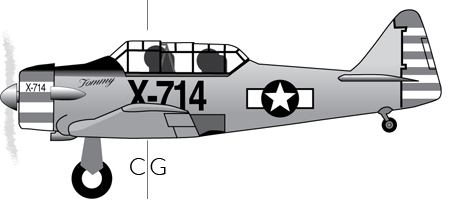A Matter of Weight and Balance
In part one Captain Billy went over the general points of Flight Balance. In part two we discuss loading Tommy to fit into his proper center of gravity.
Every aircraft wing is built with a major component called a Wing Spar. It is located along the length of the wing from tip to tip, and passes through the Fuselage, or body, of the aircraft. Along this steel, wood, or in some cases today composite (a combination of materials), is where the aircraft Center of Gravity (CG), or balance point exists. Every aircraft MUST balance within a certain area forward and aft of the spar. This is determined by the Engineers who built the aircraft. The aircraft controls, the position of the wing, and length of the fuselage, are designed to meet this requirement.
If we look at Tommy from a side view, with the landing gear down in the illustration below, we can see that the front pilot is placed directly over the wing. As you can see, the addition of a pilot in the back will affect the balance point. The two fuel tanks in Tommy’s wings are centered on the wing next to the fuselage. Tommy’s engine weighs quite a bit, as do all of the accessories and the oil tank, so it is located close to the leading edge (front) of the wing. When the weight of all the parts we mentioned are taken into consideration, the engineers come up with just how far away the tail surfaces need to be to be able to control the aircraft about the pitch, or longitudinal axis. (The imaginary line drawn through the center of the wing.)

Tommy has a small baggage compartment located behind the rear seat, which also has a weight limit that cannot be exceeded.
Just before every flight, Captain Billy has a sheet of paper that he fills out with all the weights of the pilots, fuel and baggage. The sheet also has the Empty Weight of Tommy on it. He then adds up all the weights to make sure that he has not over loaded Tommy. Then, using a graph from the Weight and Balance section of his flight manual, Captain Billy determines where the flight fits into the “center of gravity envelope.” From this information he can determine where the Elevator Trim needs to be set for takeoff. He also can determine whether he has exceeded the Maximum Takeoff Weight, both for Tommy’s limitation, as well as the available runway.
Since Captain Billy has flown Tommy often, and the load capacity of Tommy is simple, he has prepared a chart with the weights and trim settings, so all he has to do is look down one column and next to the weight is the trim setting. When Captain Billy was flying the Boeing 727 and Douglas DC-8 things were not so straight forward, because they were much bigger and carried more fuel, many more people, their luggage, and other details that had to be considered.
Blue Skys and Tailwinds,
Captain Billy
If you have any questions, email Captain Billy!
